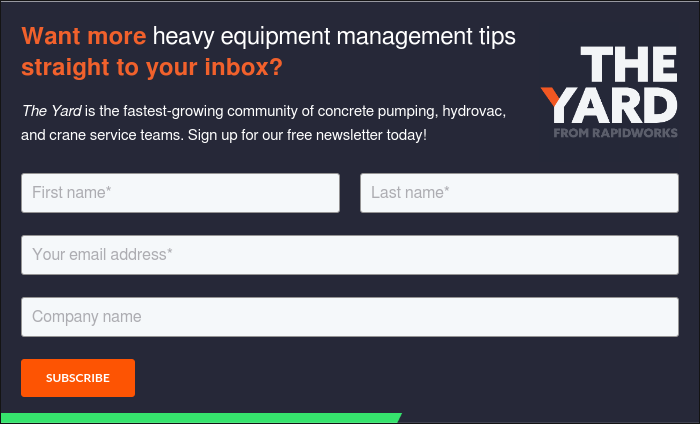How to Create Effective Crane Pre-Lift Plans That Keep Your Crew Safe

How to Create Effective Crane Pre-Lift Plans That Keep Your Crew Safe
A well-prepared crane pre-lift plan protects your crew and equipment from the serious risks that come with lifting operations. Planning for every relevant detail ahead of time helps you stay compliant and prevents costly delays stemming from a poorly executed lift.
This guide will walk you through every component of a crane pre-lift plan, what information to compile, and proven strategies for successfully implementing your plan.
This article will walk through:
- Why You Need a Crane Pre-Lift Plan
- Initial Considerations Before You Build Your Plan
- What to Include in a Crane Pre-Lift Plan
- Best Practices for Implementing Your Crane Pre-Lift Plan
- Using Technology to Improve Your Crane Pre-Lift Plan
Why You Need a Crane Pre-Lift Plan
Creating a comprehensive crane pre-lift plan is the first step to preventing accidents that can shut down your operation and put lives at risk. Without proper planning, you’re gambling with expensive equipment and your crew’s safety. Inadequate preparation and poor communication can cause injuries and costly project delays that could have been prevented.
Regulatory agencies know this, which is why they’ve established a set of regulations for preventing crane accidents. OSHA Standard 1926.1404 requires directors to review all applicable procedures before work begins and confirm that all crew members understand their tasks and the associated risks. Your pre-lift plan establishes a systematic approach to meeting these requirements by documenting all of the precautions you and your crew took before starting any work.
Building on these OSHA requirements, ASME B30.5 (American Society of Mechanical Engineers) expands on the technical aspects of crane operations. This nationally recognized standard requires operators to determine load weights and verify that they fall within the crane’s rated capacity for the planned configuration. The standard also mandates calculating the load radius and boom angle and confirming that the ground conditions can support outrigger loads. Your crane pre-lift plan should document these calculations and create a paper trail that shows you’re staying compliant.
That’s why a solid pre-lift plan protects your business from liability exposure. If something goes wrong, documented proof that you followed proper planning procedures can mean the difference between a manageable insurance claim and a lawsuit that threatens your company’s future.
Considerations Before You Build Your Plan
Before you start drafting your crane pre-lift plan, you need to gather information that will determine what an ideal operation looks like. The more details you’re able to gather up front, the fewer surprises you’ll face when it’s time to operate the crane.
Think about this before you build your plan:
- Site conditions: Walk the jobsite and evaluate access routes for your crane and support vehicles, as well as any overhead obstructions like power lines or structures. Weather conditions can also change everything about your lift, so check the forecasts and have contingency plans for high wind and heavy rain.
- Lift complexity: Lifts involving expensive or irreplaceable loads are much harder to plan than those handling routine materials. Multi-crane operations also need coordination protocols between operators.
- Team composition: Identify your crane operator, signal person, and lift director early in the planning process. Everyone involved, but especially those three people, must understand their role and have the qualifications needed for the specific lift.
- Load characteristics: Having correct weight information is one of the most important things for safely operating a crane. Estimates or outdated drawings won’t cut it when this information determines your crane’s capacity and rigging requirements. You’ll also need specific dimensions and information about any lifting points or attachment methods specified by the manufacturer.
What to Include in a Crane Pre-Lift Plan
Your crane pre-lift plan needs specific components to keep your operation safe and compliant. Every element you document helps prevent accidents and demonstrates your professionalism to both customers and regulatory inspectors.
Here are the things you should include to create a plan that covers all safety concerns while staying practical.
Lift Objective and Scope
Define exactly what you’re lifting and where it’s going. Document the specific load, its starting location, and its final destination with enough detail so that anyone reading the plan understands the operation. Include any special handling requirements, like maintaining level orientation for delicate equipment or meeting specific placement tolerances for structural components.
Crane Specifications
Document every detail about your crane's model and configuration. Include the crane’s rated capacity at the planned working radius and the boom length you’ll use. These specifications will determine whether your crane can safely handle the load, so accuracy matters more than convenience here.
Load Calculations
Accurately calculating your loads is the first step to operating a crane safely. You must verify the actual weight of your loads through engineering drawings, manufacturer specifications, physical weighing, and certified load testing when possible. Estimates create unnecessary risks when your crane’s capacity and your crew’s safety depend on precise information.
Rigging Plan
Create a clear rigging diagram that shows exactly how your crew will attach the load and position the rigging hardware. Include details about lifting points and sling routing to protect the load from damage. Your diagram should have enough details so that your rigger can set up the lift correctly, even without prior experience with this specific load.
Lift Path and Positioning
Map out the complete path your load will travel, from pickup to final placement. Identify obstacles along the route and overhead restrictions that could interfere with your operation. This planning helps you position your crane optimally while alerting your crew to potential hazards along the way.
As you map out the path, establish clear exclusion zones around your crane and along the load’s travel route. These boundaries protect your crew and provide clear guidance for coordinating with other trades working nearby.
Personnel Roles
You need to assign specific responsibilities to each team member involved in the lift. Clearly identify who will operate the crane, who will provide signals, who will direct the overall operation, and who will serve as the backup if your primary team members are unavailable.
Communication Protocol
Designate primary and backup communication methods for your operation. You should specify whether you’ll use hand signals or radio communications, and confirm that everyone understands what the signals mean and what the two-way radio protocols are.
This is also a good time to address any language barriers or special communication needs that might affect your operation. If you’re working with multicultural crews, then using standardized signals that don’t rely on spoken language can prevent dangerous misunderstandings.
Emergency Procedures
You should create contingency plans for common emergency scenarios like equipment failure or severe weather. Include specific steps your crew should take, and clearly identify who has the authority to stop the operation if the conditions become unsafe. Having these procedures documented in advance prevents confusion when making quick decisions is most important.
Best Practices for Implementing Your Crane Pre-Lift Plan
Creating a solid crane pre-lift plan is only half the battle. The real value comes from implementing that plan consistently and thoroughly on every job. Follow these best practices for helping your crew understand that the plan is more than just paperwork:
- Hold pre-lift meetings: Gather your entire crew before starting any work to review the plan and discuss the potential hazards. This meeting gives team members a chance to ask questions and voice their concerns before starting the operation.
- Verify equipment specifications: Check that your crane configuration matches the plan's specifications and inspect all rigging hardware for damage or wear. You should confirm that the load weights and dimensions match your documented calculations, as discrepancies here can compromise the entire operation.
- Use systematic checklists: Create a standardized checklist that covers the most important parts of your pre-lift plan. Having your crew work through this checklist systematically prevents oversight of important safety measures during busy or stressful periods.
- Document everything: Keep detailed records of your planning process and any approvals required for the operation.
- Practice dry runs: Walk through the entire lift sequence without the load to spot any potential problems and verify that your crew understands the operation. This practice run can help you find issues that weren’t there or weren’t apparent during the planning phase.
- Adapt when conditions change: Monitor conditions throughout the operation and be prepared to modify your plan when circumstances change. Even the best plan can’t account for every possible scenario, so it’s important to stay flexible.
Using Technology to Improve Your Crane Pre-Lift Plan
Digital planning tools streamline your documentation and improve communication across your entire team. Solutions like Visual Dispatch, RapidWorks' premier job management solution built for the crane industry, give you centralized visibility into your operations, integrated documentation, automated checklists, and digital records that improve accountability while simplifying compliance tracking. Schedule a demo today to learn more about how Visual Dispatch can help you and your crane team solidify safety.
